2010 SUBARU FORESTER airbag
[x] Cancel search: airbagPage 26 of 402
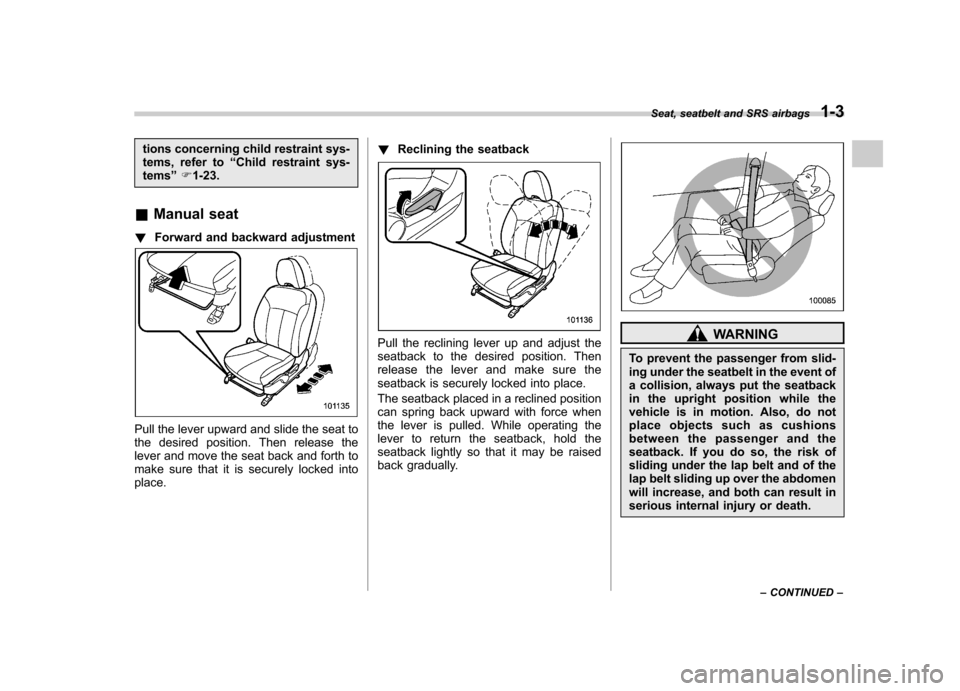
tions concerning child restraint sys-
tems, refer to“Child restraint sys-
tems ”F 1-23.
& Manual seat
! Forward and backward adjustment
Pull the lever upward and slide the seat to
the desired position. Then release the
lever and move the seat back and forth to
make sure that it is securely locked intoplace. !
Reclining the seatback
Pull the reclining lever up and adjust the
seatback to the desired position. Then
release the lever and make sure the
seatback is securely locked into place.
The seatback placed in a reclined position
can spring back upward with force when
the lever is pulled. While operating the
lever to return the seatback, hold the
seatback lightly so that it may be raised
back gradually.WARNING
To prevent the passenger from slid-
ing under the seatbelt in the event of
a collision, always put the seatback
in the upright position while the
vehicle is in motion. Also, do not
place objects such as cushions
between the passenger and the
seatback. If you do so, the risk of
sliding under the lap belt and of the
lap belt sliding up over the abdomen
will increase, and both can result in
serious internal injury or death. Seat, seatbelt and SRS airbags
1-3
– CONTINUED –
Page 27 of 402

1-4Seat, seatbelt and SRS airbags
! Seat cushion height adjustment (driver ’s seat)
1) When the lever is pushed down, the seat
is lowered.
2) When the lever is pulled up, the seat rises.
The height of the seat can be adjusted by
moving the seat cushion adjustment lever
up and down. &
Power seat (driver ’s seat –if
equipped)
1) Seat position forward/backward con-
trol switch
To adjust the seat forward or backward,
move the control switch forward or
backward. During forward/backward ad- justment of the seat, you cannot adjust
the seat cushion angle or seat cushion height.
2) Seat cushion angle control switch
To adjust the seat cushion angle, pull up
or push down the front end of the control switch.
3) Seatback angle (r eclining) control
switch
To adjust the angle of the seatback,
move the control switch.
4) Seat height control switch
To adjust the seat height, pull up or push
down the rear end of the control switch.
5) Lumbar support control switch
To increase lumbar support, push the
front side of the switch. To decrease
lumbar support, push the rear side of the switch.
Page 28 of 402
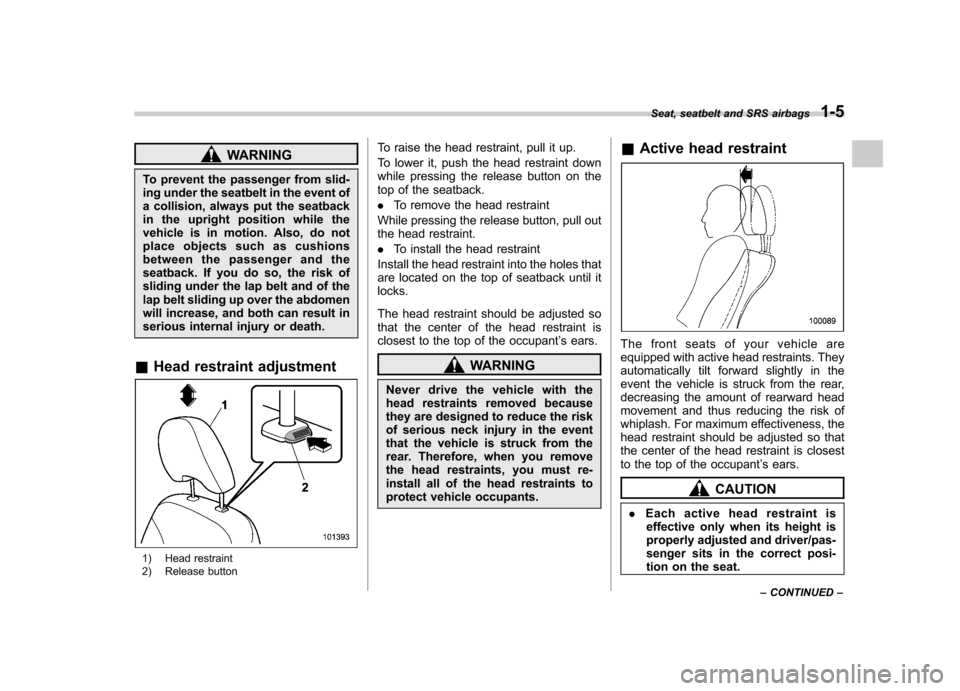
WARNING
To prevent the passenger from slid-
ing under the seatbelt in the event of
a collision, always put the seatback
in the upright position while the
vehicle is in motion. Also, do not
place objects such as cushions
between the passenger and the
seatback. If you do so, the risk of
sliding under the lap belt and of the
lap belt sliding up over the abdomen
will increase, and both can result in
serious internal injury or death.
& Head restraint adjustment
1) Head restraint
2) Release button To raise the head restraint, pull it up.
To lower it, push the head restraint down
while pressing the release button on the
top of the seatback. .
To remove the head restraint
While pressing the release button, pull out
the head restraint. . To install the head restraint
Install the head restraint into the holes that
are located on the top of seatback until itlocks.
The head restraint should be adjusted so
that the center of the head restraint is
closest to the top of the occupant ’s ears.
WARNING
Never drive the vehicle with the
head restraints removed because
they are designed to reduce the risk
of serious neck injury in the event
that the vehicle is struck from the
rear. Therefore, when you remove
the head restraints, you must re-
install all of the head restraints to
protect vehicle occupants. &
Active head restraint
The front seats of your vehicle are
equipped with active head restraints. They
automatically tilt forward slightly in the
event the vehicle is struck from the rear,
decreasing the amount of rearward head
movement and thus reducing the risk of
whiplash. For maximum effectiveness, the
head restraint should be adjusted so that
the center of the head restraint is closest
to the top of the occupant ’s ears.
CAUTION
. Each active head restraint is
effective only when its height is
properly adjusted and driver/pas-
senger sits in the correct posi-
tion on the seat. Seat, seatbelt and SRS airbags
1-5
– CONTINUED –
Page 29 of 402
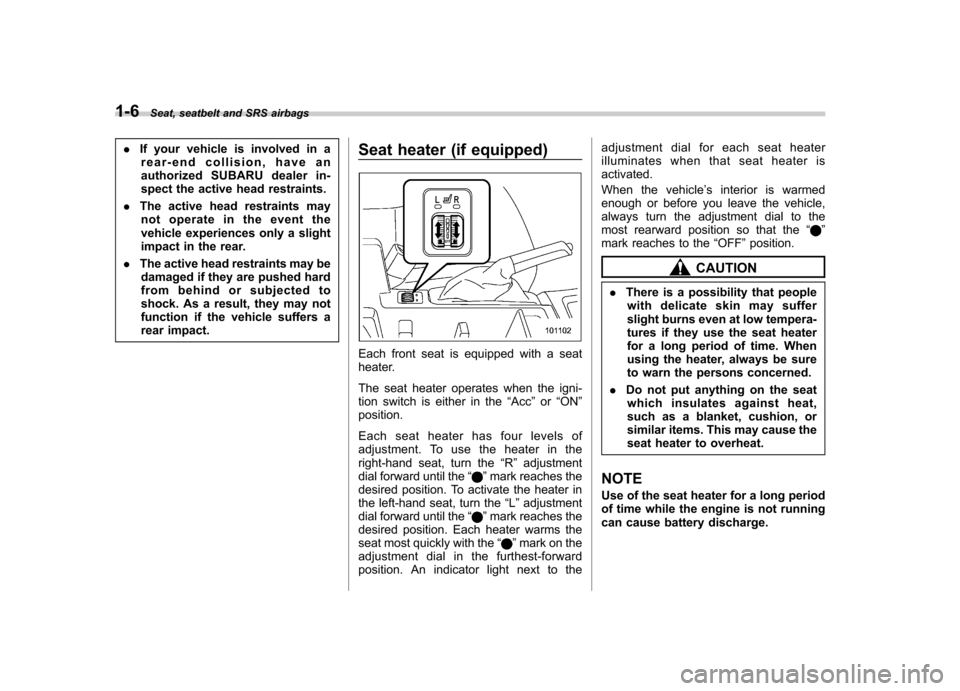
1-6Seat, seatbelt and SRS airbags
.If your vehicle is involved in a
rear-end collision, have an
authorized SUBARU dealer in-
spect the active head restraints.
. The active head restraints may
not operate in the event the
vehicle experiences only a slight
impact in the rear.
. The active head restraints may be
damaged if they are pushed hard
from behind or subjected to
shock. As a result, they may not
function if the vehicle suffers a
rear impact. Seat heater (if equipped)
Each front seat is equipped with a seat
heater.
The seat heater operates when the igni-
tion switch is either in the
“Acc ”or “ON ”
position.
Each seat heater has four levels of
adjustment. To use the heater in the
right-hand seat, turn the “R ” adjustment
dial forward until the “
”mark reaches the
desired position. To activate the heater in
the left-hand seat, turn the “L ” adjustment
dial forward until the “
”mark reaches the
desired position. Each heater warms the
seat most quickly with the “
”mark on the
adjustment dial in the furthest-forward
position. An indicator light next to the adjustment dial for each seat heater
illuminates when that seat heater isactivated.
When the vehicle
’s interior is warmed
enough or before you leave the vehicle,
always turn the adjustment dial to the
most rearward position so that the “
”
mark reaches to the “OFF ”position.
CAUTION
. There is a possibility that people
with delicate skin may suffer
slight burns even at low tempera-
tures if they use the seat heater
for a long period of time. When
using the heater, always be sure
to warn the persons concerned.
. Do not put anything on the seat
which insulates against heat,
such as a blanket, cushion, or
similar items. This may cause the
seat heater to overheat.
NOTE
Use of the seat heater for a long period
of time while the engine is not running
can cause battery discharge.
Page 30 of 402

Rear seats
WARNING
Seatbelts provide maximum re-
straint when the occupant sits well
back and upright in the seat. Do not
put cushions or any other materials
between occupants and seatbacks
or seat cushions. If you do so, the
risk of sliding under the lap belt and
of the lap belt sliding up over the
abdomen will increase, and both can
result in serious internal injury ordeath.
WARNING
Never stack luggage or other cargo
higher than the top of the seatback
because it could tumble forward and
injure passengers in the event of a
sudden stop or accident. &
ArmrestTo lower the armrest, pull on the top edge
of the armrest.
WARNING
To avoid the possibility of serious
injury, passengers must never be
allowed to sit on the center armrest
while the vehicle is in motion. Seat, seatbelt and SRS airbags
1-7
– CONTINUED –
Page 31 of 402
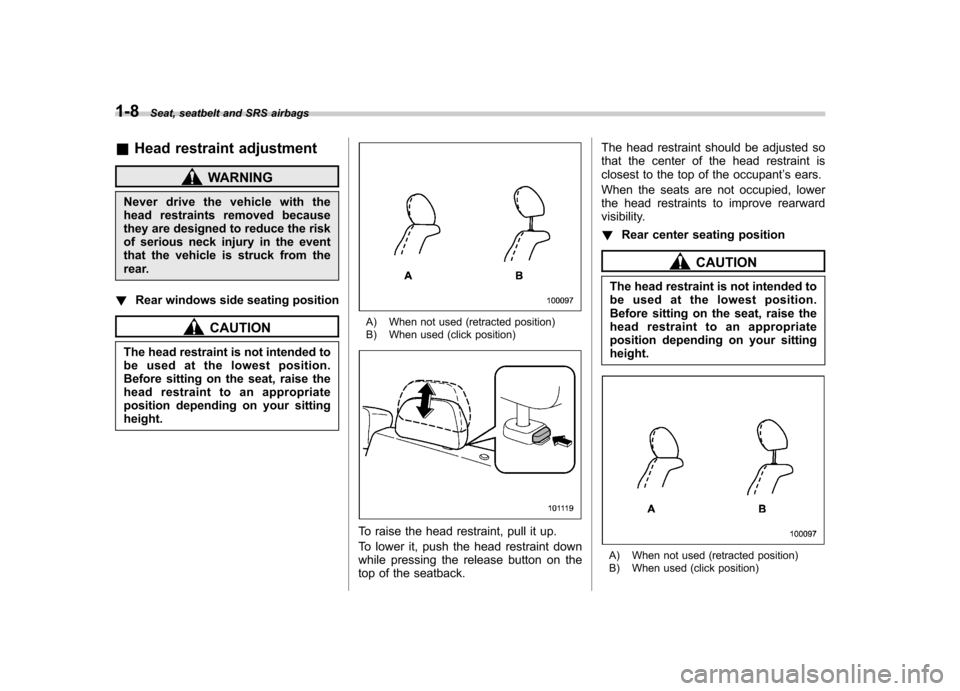
1-8Seat, seatbelt and SRS airbags
&Head restraint adjustment
WARNING
Never drive the vehicle with the
head restraints removed because
they are designed to reduce the risk
of serious neck injury in the event
that the vehicle is struck from the
rear.
! Rear windows side seating position
CAUTION
The head restraint is not intended to
be used at the lowest position.
Before sitting on the seat, raise the
head restraint to an appropriate
position depending on your sittingheight.A) When not used (retracted position)
B) When used (click position)
To raise the head restraint, pull it up.
To lower it, push the head restraint down
while pressing the release button on the
top of the seatback. The head restraint should be adjusted so
that the center of the head restraint is
closest to the top of the occupant
’s ears.
When the seats are not occupied, lower
the head restraints to improve rearward
visibility. ! Rear center seating position
CAUTION
The head restraint is not intended to
be used at the lowest position.
Before sitting on the seat, raise the
head restraint to an appropriate
position depending on your sittingheight.
A) When not used (retracted position)
B) When used (click position)
Page 32 of 402

To raise the head restraint, pull it up while
pressing the release button on the top of
the seatback.
To lower it, push the head restraint down
while pressing the release button.
When the rear-center seating position is
occupied, raise the head restraint to an
appropriate position depending on your
sitting height. When the rear center seat-
ing position is not occupied, lower the
head restraint to improve rearward visibi-
lity.&
Reclining the seatback (if equipped)
WARNING
To prevent the passenger from slid-
ing under the seatbelt in the event of
a collision, always put the seatback
in the upright position while the
vehicle is in motion. Also, do not
place objects such as cushions
between the passenger and the
seatback. If you do so, the risk of
sliding under the lap belt and of the
lap belt sliding up over the abdomen
will increase, and both can result in
serious internal injury or death.
CAUTION
If the vehicle is equipped with a
cargo area cover, observe the fol-
lowing precautions. . Be careful not to pinch your hand
between the headrest and the
cargo area cover when you re-
cline the rear seat.
. Move the front cover of the cargo
area cover backward so that the
cover is not damaged by the
reclined seatback. Refer to “Car-
go area cover (dealer option) ”
F 6-13.
Push the switch and adjust the seatback
to the desired position. Seat, seatbelt and SRS airbags
1-9
– CONTINUED –
Page 33 of 402
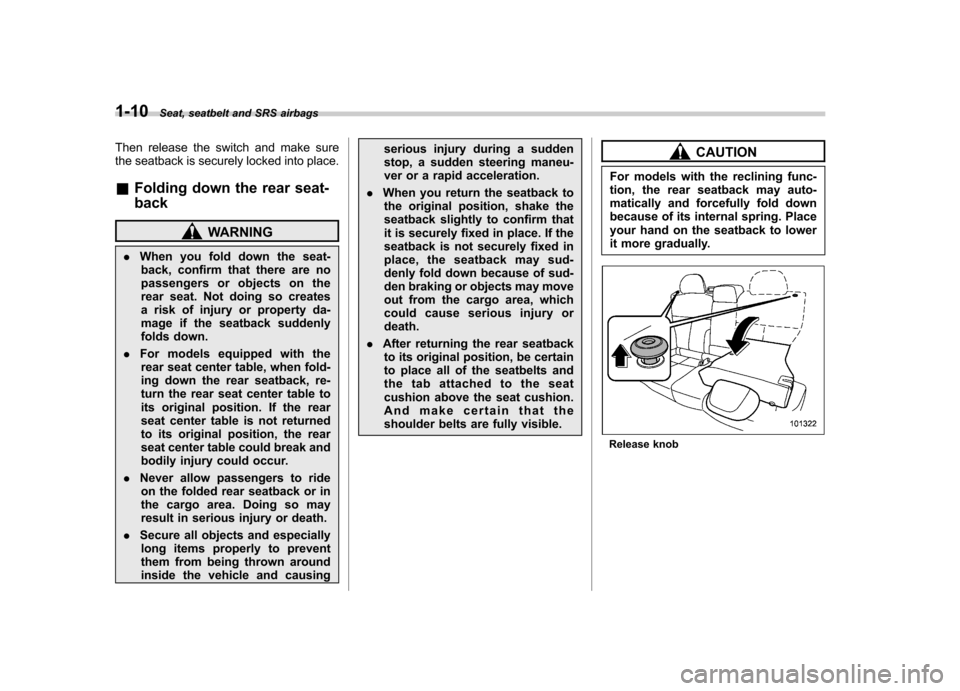
1-10Seat, seatbelt and SRS airbags
Then release the switch and make sure
the seatback is securely locked into place. &Folding down the rear seat- back
WARNING
. When you fold down the seat-
back, confirm that there are no
passengers or objects on the
rear seat. Not doing so creates
a risk of injury or property da-
mage if the seatback suddenly
folds down.
. For models equipped with the
rear seat center table, when fold-
ing down the rear seatback, re-
turn the rear seat center table to
its original position. If the rear
seat center table is not returned
to its original position, the rear
seat center table could break and
bodily injury could occur.
. Never allow passengers to ride
on the folded rear seatback or in
the cargo area. Doing so may
result in serious injury or death.
. Secure all objects and especially
long items properly to prevent
them from being thrown around
inside the vehicle and causing serious injury during a sudden
stop, a sudden steering maneu-
ver or a rapid acceleration.
. When you return the seatback to
the original position, shake the
seatback slightly to confirm that
it is securely fixed in place. If the
seatback is not securely fixed in
place, the seatback may sud-
denly fold down because of sud-
den braking or objects may move
out from the cargo area, which
could cause serious injury ordeath.
. After returning the rear seatback
to its original position, be certain
to place all of the seatbelts and
the tab attached to the seat
cushion above the seat cushion.
And make certain that the
shoulder belts are fully visible.
CAUTION
For models with the reclining func-
tion, the rear seatback may auto-
matically and forcefully fold down
because of its internal spring. Place
your hand on the seatback to lower
it more gradually.
Release knob